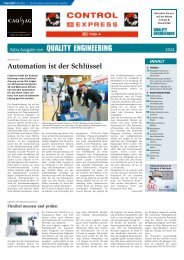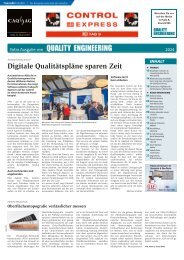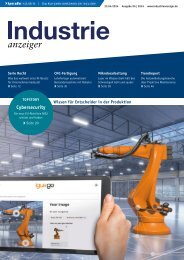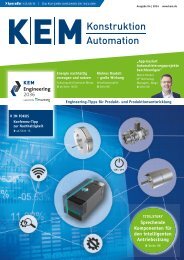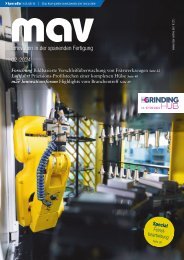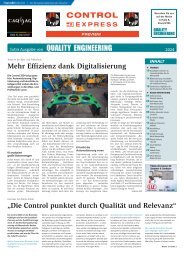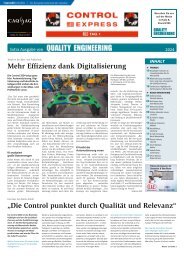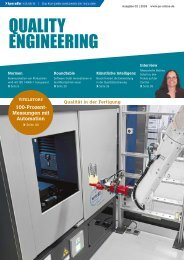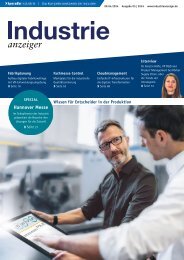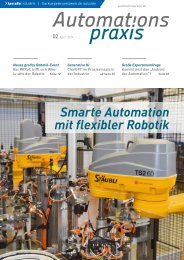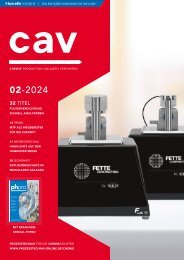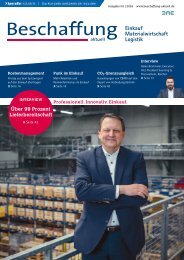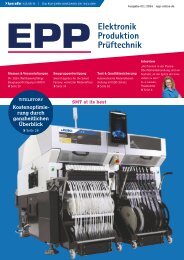cpp – Process technology for the chemical industry 02.2020
The journal cpp - Process technology for the chemical industry reports about processes, plants, apparatus and components for the chemical and pharmaceutical industry. Further topics are IT technologies, industry 4.0, digital production, MSR and automation technology and process analysis technology. The content spectrum is rounded off by explosion protection, plant safety, occupational health and safety, maintenance, site management and energy management.
The journal cpp - Process technology for the chemical industry reports about processes, plants, apparatus and components for the chemical and pharmaceutical industry. Further topics are IT technologies, industry 4.0, digital production, MSR and automation technology and process analysis technology. The content spectrum is rounded off by explosion protection, plant safety, occupational health and safety, maintenance, site management and energy management.
Create successful ePaper yourself
Turn your PDF publications into a flip-book with our unique Google optimized e-Paper software.
<strong>cpp</strong><br />
PLANTS, APPARATUS, COMPONENTS<br />
Digital tools optimise per<strong>for</strong>mance of tablet presses and capsule filling machines<br />
Full speed ahead <strong>for</strong> smart<br />
solid <strong>for</strong>mulation production<br />
In exceptional times such as <strong>the</strong> corona crisis, it becomes apparent just how fast and<br />
comprehensively pharmaceutical manufacturers need to react to changing production<br />
conditions. Demand and availability can change at any time. Such requirements<br />
on agility can be organized more efficiently using digital tools. Fette Compacting is<br />
now making a comprehensive set of digital solutions available <strong>for</strong> tablet and capsule<br />
production.<br />
Even be<strong>for</strong>e <strong>the</strong> spread of Sars-CoV-2, it<br />
was clear that digital tools are decisive factors<br />
<strong>for</strong> <strong>the</strong> success of future pharmaceutical<br />
production. Now corona has significantly<br />
increased <strong>the</strong> necessity of such aids. For<br />
example, it is now more important than<br />
ever to be able to use live chats and video<br />
conferences <strong>for</strong> remote maintenance as well<br />
as augmented reality applications <strong>for</strong> increased<br />
precision.<br />
What helps here are particularly agile<br />
methods in order to become more flexible<br />
and deploy resources specifically. Even if <strong>the</strong><br />
main processes associated with tableting<br />
and capsule filling remain mechanical <strong>for</strong><br />
<strong>the</strong> <strong>for</strong>eseeable future, digital solutions will<br />
mean that all associated processes will,<br />
however, become more efficient, faster, and<br />
safer.<br />
Agile methods <strong>for</strong> faster development<br />
The question as to how digital tools can optimize<br />
pharmaceutical production is a core<br />
issue at Fette Compacting. On <strong>the</strong> basis of<br />
For efficient troubleshooting, a smart remote tool enables personal live chats and video<br />
conferences with experts<br />
Pictures: Fette Compacting<br />
pharmacists’ requirements, a new division is<br />
developing software solutions <strong>for</strong> manufacturing<br />
tablets and capsules. The central focus<br />
is on improving <strong>the</strong> efficiency of production<br />
as a whole in that operators, maintenance<br />
technicians, and <strong>the</strong>ir supervisors are<br />
supported and data utilized intelligently.<br />
The new division goes by <strong>the</strong> name of OSDi<br />
and builds a bridge between <strong>the</strong> manufacture<br />
of Oral Solid Dosages and <strong>the</strong> digital<br />
future. The OSDi team utilizes <strong>the</strong> agile<br />
methods of Design Thinking and Lean Startup<br />
which are also widely established in Silicon<br />
Valley. These methods are linked by <strong>the</strong><br />
fact that <strong>the</strong>y are consistently oriented toward<br />
<strong>the</strong> requirements of users. In fact,<br />
users are included in <strong>the</strong> development process<br />
right from <strong>the</strong> start, particularly operators,<br />
maintenance technicians, production<br />
managers, and quality managers.<br />
In practice, this translates into an agile approach<br />
entailing <strong>the</strong> OSDi team initially<br />
drawing up new product sketches on <strong>the</strong><br />
basis of users’ “pains and gains”. These are<br />
<strong>the</strong>n sent back to <strong>the</strong> customer <strong>for</strong> a second<br />
opinion. Using <strong>the</strong> feedback obtained, <strong>the</strong><br />
unit collaborates closely with <strong>the</strong> customers<br />
to create a click dummy, a prototype, and<br />
finally <strong>the</strong> finished tool. The customer’s<br />
perspective is decisive at all times. This way,<br />
ideas with less potential can be detected<br />
swiftly and rejected if necessary, which<br />
reduces <strong>the</strong> development process and conserves<br />
resources.<br />
Interactive learning content<br />
Some digital tools have already been created<br />
on this basis at Fette Compacting. And <strong>the</strong>y<br />
44 <strong>cpp</strong> 02-2020



